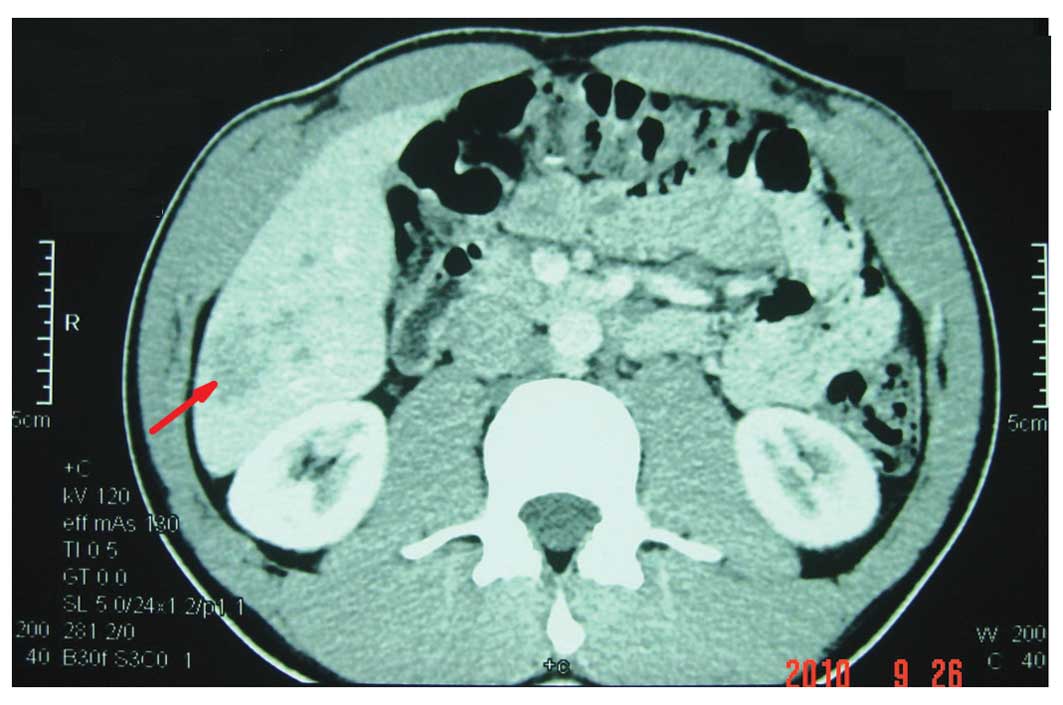|
1
|
Zak FG: Peliosis hepatis. Am J Pathol.
26:1–15. 1950.PubMed/NCBI
|
|
2
|
Iannaccone R, Federle MP, Brancatelli G,
et al: Peliosis hepatis: spectrum of imaging findings. AJR Am J
Roentgenol. 187:W43–W52. 2006. View Article : Google Scholar : PubMed/NCBI
|
|
3
|
Garcia-Tsao G, Panzini L, Yoselevitz M and
West AB: Bacillary peliosis hepatis as a cause of acute anemia in a
patient with the acquired immunodeficiency syndrome.
Gastroenterology. 102:1065–1070. 1992.PubMed/NCBI
|
|
4
|
Wagner E: Ein fall von blutcysten in der
leber. Arc Heilkunde. 2:369–370. 1861.(In German).
|
|
5
|
Schoenlank W: Ein fall von peliosis
hepatis. Virchows Arch A Pathol Anat. 222:358–364. 1916.(In
German).
|
|
6
|
Slater LN, Welch DF and Min KW:
Rochalimaea henselae causes bacillary angiomatosis and
peliosis hepatis. Arch Intern Med. 152:602–606. 1992. View Article : Google Scholar
|
|
7
|
Kitchell BE, Fan TM, Kordick D,
Breitschwerdt EB, Wollenberg G and Lichtensteiger CA: Peliosis
hepatis in a dog infected with Bartonella henselae. J Am Vet
Med Assoc. 216:519–523. 2000. View Article : Google Scholar : PubMed/NCBI
|
|
8
|
Koehler JE: Bartonella-associated
infections in HIV-infected patients. AIDS Clin Care. 7:97–102.
1995.PubMed/NCBI
|
|
9
|
Lie JT: Pulmonary peliosis. Arch Pathol
Lab Med. 109:878–879. 1985.PubMed/NCBI
|
|
10
|
Nadell J and Kosek J: Peliosis hepatis.
Twelve cases associated with oral androgen therapy. Arch Pathol Lab
Med. 101:405–410. 1977.PubMed/NCBI
|
|
11
|
Tsutsumi Y, Ito S, Ichiki K, et al:
Systemic amyloidosis complicated with peliosis. Ann Hematol.
88:917–920. 2009. View Article : Google Scholar : PubMed/NCBI
|
|
12
|
Buchmann AU, Kempf VA, Kershaw O and
Gruber AD: Peliosis hepatis in cats is not associated with
Bartonella henselae infections. Vet Pathol. 47:163–166.
2010. View Article : Google Scholar : PubMed/NCBI
|
|
13
|
Edwards R, Colombo T and Greaves P: ‘Have
you seen this?’peliosis hepatis. Toxicologic Pathol. 30:521–523.
2002.
|
|
14
|
Malet PF and Moonka D: Peliosis hepatis:
old disease, new cause. Gastroenterology. 101:864–866.
1991.PubMed/NCBI
|
|
15
|
Zafrani ES, Pinaudeau Y, Le Cudonnec B,
Julien M and Dhumeaux D: Focal hemorrhagic necrosis of the liver. A
clinicopathological entity possibly related to oral contraceptives.
Gastroenterology. 79:1295–1299. 1980.PubMed/NCBI
|
|
16
|
Bagheri SA and Boyer JL: Peliosis hepatis
associated with androgenic-anabolic steroid therapy. A severe form
of hepatic injury. Ann Intern Med. 81:610–618. 1974. View Article : Google Scholar : PubMed/NCBI
|
|
17
|
Kleger A, Bommer M, Kunze M, et al: First
reported case of disease: peliosis hepatis as cardinal symptom of
Hodgkin’s lymphoma. Oncologist. 14:1088–1094. 2009.PubMed/NCBI
|
|
18
|
Kim SH, Lee JM, Kim WH, Han JK, Lee JY and
Choi BI: Focal peliosis hepatis as a mimicker of hepatic tumors:
radiological-pathological correlation. J Comput Assist Tomogr.
31:79–85. 2007. View Article : Google Scholar : PubMed/NCBI
|
|
19
|
Gouya H, Vignaux O, Legmann P, de Pigneux
G and Bonnin A: Peliosis hepatis: triphasic helical CT and dynamic
MRI findings. Abdom Imaging. 26:507–509. 2001. View Article : Google Scholar : PubMed/NCBI
|
|
20
|
Savastano S, San Bortolo O, Velo E,
Rettore C and Altavilla G: Pseudotumoral appearance of peliosis
hepatis. AJR Am J Roentgenol. 185:558–559. 2005. View Article : Google Scholar : PubMed/NCBI
|
|
21
|
Radin DR and Kanel GC: Peliosis hepatis in
a patient with human immunodeficiency virus infection. AJR Am J
Roentgenol. 156:91–92. 1991. View Article : Google Scholar : PubMed/NCBI
|











